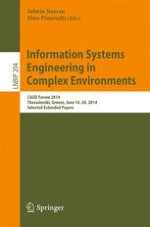This book constitutes the proceedings of the CAiSE Forum from the 26th International Conference on Advanced Information Systems Engineering, CAiSE 2014, held in Thessaloniki, Greece, June 2014.
The CAiSE 2014 Forum was a place to present and discuss new ideas, emerging topics, and controversial positions, and to demonstrate innovative tools and systems related to information systems engineering. To this end, three types of submissions were invited: visionary papers presenting innovative research projects at an early stage, demo papers describing novel tools and prototypes; and case studies reporting industrial applications. The 17 papers in this volume were carefully reviewed and selected from 45 submissions and include 12 visionary papers, four demo papers, and one case study. The reworked and extended versions of the original presentations cover topics such as business process management, process mining, enterprise architecture and modeling, model-driven development, and requirements engineering.
